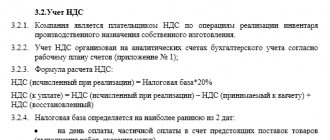Why is accounting policy needed?
An accounting policy is a document in which an organization consolidates the chosen methods of accounting. Those that take into account the specifics of its activities.
The accounting policy requirements are specified in paragraph 6 of PBU 1/2008. Among them, for example:
- a complete reflection of all factors of economic activity, that is, all transactions without exception must be reflected in accounting;
- timely accounting of transactions, that is, they must be shown in the periods in which they were completed;
- priority of the economic content of the facts of economic activity over their legal form. For example, operations related to the acceptance and transfer of a leased property must be reflected in accounting, regardless of the date of state registration of the lease agreement (Resolution of the Federal Antimonopoly Service of the North-Western District dated February 25, 2005 No. A42-6647/03-20).
Changing an organization's accounting policy
Do I need to draw up an accounting policy every year or draw it up once and then make changes if necessary? Are changes made by additional points repeating the “old” or only additional points?
In accordance with Art. 6 of the Federal Law of the Russian Federation of November 21, 1996 No. 129-FZ “On Accounting”
The accounting policies adopted by the organization are applied consistently from year to year.
Change in accounting policy
may be carried out in cases of changes in the legislation of the Russian Federation or regulations of bodies regulating accounting, the development by an organization of new methods of accounting, or a significant change in the conditions of its activities.
In order to ensure comparability of accounting data, changes in accounting policies must be introduced from the beginning of the financial year
.
The accounting policy adopted by the organization is approved by order or instruction of the person responsible for the organization and state of accounting.
And responsibility
The heads of organizations
are responsible for organizing accounting in organizations and complying with the law when carrying out business operations .
That is, changes in accounting policies are also approved by order of the head of the organization.
The rules for the formation (selection or development) and disclosure of the accounting policies of organizations that are legal entities under the laws of the Russian Federation are established by PBU 1/2008 “Accounting policies of an organization”
, approved by order of the Ministry of Finance of the Russian Federation dated October 6, 2008 No. 106n.
According to clause 10 of PBU 1/2008, a change in the accounting policy of an organization can be made in cases
:
– changes in Russian legislation
and (or) regulatory legal acts on accounting;
– development by the organization of new ways
accounting.
The use of a new method of accounting implies a more reliable representation of the facts of economic activity in the accounting and reporting of the organization or less labor intensity of the accounting process without reducing the degree of reliability of the information;
– significant change
business conditions.
A significant change in the business conditions of an organization may be associated with reorganization, change in types of activities, etc.
This is not considered a change in accounting policy
approval of the method of accounting for facts of economic activity that are different in essence from facts that occurred earlier, or arose for the first time in the activities of the organization.
That is, if your company decided to engage in a type of activity different from the type of activity being carried out (for example, there was production and trade was added), then the accounting policy needs to include the necessary provisions governing the methods of accounting and tax accounting of trade operations.
In this case, this will not be regarded as a change in accounting policy.
You simply supplement the accounting policy
with the necessary provisions.
Change in accounting policy
subject to registration with the relevant organizational and administrative documentation (
orders, instructions, etc.
)
of the organization
.
As a rule, this is formalized by an order from the head of the organization to amend the Regulations on the accounting policies of the organization.
Neither the accounting law nor PBU 1/2008 establishes how changes should be formulated
.
Therefore, each organization does what is most convenient for it.
You can simply state the new edition of the Accounting Policy Regulations
, taking into account all the changes made.
In practice, this is more convenient because there is no need to compare two documents.
Or you can simply indicate in the change order that point such and such should be stated in such and such a way
.
In any case there will be no violation.
Don't forget that changes to your accounting policies
for the next reporting year, the organization must
declare in an explanatory note
about the financial statements (clause 4 of article 13 of the Accounting Law).
Composition of accounting policies
Accounting policies should include:
- working chart of accounts;
- forms of primary documents;
- accounting registers;
- forms of documents for internal accounting reporting (if the organization plans to prepare it);
- inventory procedure;
- methods for assessing assets and liabilities;
- document flow procedures, accounting information processing technology;
- the procedure for monitoring business operations;
- other elements and principles influencing the organization of accounting.
Such rules are established by paragraph 4 of PBU 1/2008.
Who should develop accounting policies
The accounting policy is developed by the chief accountant or another employee responsible for accounting in the organization (for example, a manager). The accounting policy is approved by the head of the organization. This is stated in paragraph 4 of PBU 1/2008.
An order for approval of accounting policies can be drawn up in any form.
Situation: is an organization applying the simplification required to develop accounting policies for accounting purposes?
Yes, I must.
Organizations using the simplified system are required to keep accounting records in full (Article 2, 6 of the Law of December 6, 2011 No. 402-FZ). Therefore, an organization applying the simplification is obliged to develop and approve an accounting policy for accounting purposes. Such conclusions can be drawn from the provisions of paragraphs 1–3 of PBU 1/2008 and Article 8 of the Law of December 6, 2011 No. 402-FZ.
What should not be included in accounting policies
- Excerpts from instructions on accounting. In particular, there is no need to rewrite the words “when accounting, the accrual method is used.” Only what the institution has chosen from the options proposed by the instructions and rules should be indicated. For example, which of the three depreciation methods is adopted as the basis, how to keep records on off-balance sheet accounts, at what cost to write off inventories, and how to make entries agreed upon with the founder.
- Norms of labor, civil and tax legislation. They do not apply to accounting rules. For example, the procedure for calculating travel allowances and calculating wages is regulated by labor legislation and local regulations of the institution. And relations with counterparties - civil legislation and procurement laws.
- Personal data of employees, for example, full name. After all, if an employee quits, the accounting policy will have to be adjusted, and this can only be done in exceptional cases.
- Methods and methods of accounting that do not relate to the types of activities of the institution.
This conclusion follows from Article 8 of the Federal Law of December 6, 2011 No. 402?FZ, paragraph 4 of the methodological recommendations, which were communicated by letter of the Ministry of Finance of Russia dated August 31, 2021 No. 02-06-07/62480.
When and how often to approve accounting policies
The newly created organization and those that emerged as a result of the reorganization must approve the accounting policy within 90 days from the date of state registration. This document must be applied from the moment the new organization (successor organization) is created. This procedure is established by paragraph 2 of clause 9 of PBU 1/2008. At the same time, there are no penalties for violating the deadlines for approving accounting policies.
The adopted accounting policy can and should be applied consistently from year to year (Part 5 of Article 8 of the Law of December 6, 2011 No. 402-FZ). That is, there is no need to approve a new document every year.
Validity period of the accounting policy
The period during which the accounting policy is valid is not established by law. But, as a rule, accounting policies are approved once and applied consistently from year to year. This conclusion follows from parts 5–7 of Article 8 of Federal Law No. 402?FZ, paragraph 11 of the standard “Accounting Policies, Estimates and Errors”. An institution can establish a specific period for applying accounting policies, for example, issue an order approving it for one year. In this case, by the beginning of each next year, an order to extend the validity of the accounting policy must be issued.
Selecting accounting methods
The accounting policy establishes accounting methods selected from several provided by law. The list of possible options from which you need to choose one is presented in the table. If the law specifies the only method of accounting for specific transactions, then it is not necessary to indicate it in the accounting policy.
However, regulatory documents do not provide accounting methods for all transactions. In this case, develop your own methodology based on the provisions of other PBUs or IFRS rules.
This procedure is provided for in paragraph 7 of PBU 1/2008.
Organizations that belong to the category of micro-enterprises or non-profit organizations can conduct accounting using a simple system (without using double entry) or in a general manner - using the double entry method. Therefore, such organizations can choose to maintain their records. They must register their choice in the accounting policy. This procedure is provided for in paragraph 6.1 of PBU 1/2008 and part 4 of article 6 of the Law of December 6, 2011 No. 402-FZ.
Situation: is it possible in the accounting policy for accounting purposes to establish different valuation methods for different groups of inventories?
Yes, you can.
For each group (type) of inventories, the organization has the right to choose the most convenient way to evaluate them upon disposal (write-off for production) (clause 16 of PBU 5/01). Each of the selected methods in relation to each group of inventories must be fixed in the accounting policy for accounting purposes (clause 7 of PBU 1/2008).
Information about accounting policies in reporting
Information about accounting policies must be disclosed in the Notes to the Balance Sheet and the Statement of Financial Results. There you will also need to provide information about the changed accounting policy.
Thus, having updated the accounting policy in the reporting year, the following information must be disclosed in the Explanations to the Balance Sheet and the Financial Results Report:
- the reason for the change;
- content of updated or new items;
- the order in which the consequences of changes in accounting policies will be reflected in the financial statements (retrospectively or prospectively);
- the amount of adjustments associated with changes in accounting policies for each item in the financial statements for each of the reporting periods presented;
- the amount of the corresponding adjustment relating to reporting periods prior to those presented in the financial statements, to the extent practicable.
This procedure is provided for in paragraph 21 of PBU 1/2008.
At the same time, changes in accounting policies that have had or are capable of having a significant impact on the financial position of the organization, the financial results of its activities and (or) cash flows must be shown separately in the financial statements (clause 16 of PBU 1/2008).
Myth No. 1: accounting policies must be changed every year
Nobody argues with the fact that there should be an accounting policy in any organization. But many companies approach its development formally, without really studying the consequences of using certain elements. Others duplicate almost all legal norms in their accounting policies, according to the principle “you can’t spoil porridge with butter,” which is also hardly useful. In this article we will analyze the most popular misconceptions regarding the preparation of accounting policies and suggest the correct solutions.
Let's start with an axiom: the accounting policy of an organization is the set of accounting methods adopted by it (primary observation, cost measurement, current grouping and final generalization of the facts of economic activity). The accounting policy chosen by the organization has a significant impact on the value of the indicators of production costs, profits, value added and property taxes, and indicators of the financial condition of the organization. Consequently, the accounting policy of an organization is an important means of forming the values of the main indicators of its activities, tax planning, and pricing policy. Now let’s move on to the analysis of “myths and legends”.
Note! Small enterprises may not create a reserve in accounting for a decrease in the cost of inventories if they stipulate this in their accounting policies (clause 25 of PBU 5/01).
It is not true. Change accounting policies as necessary. To do this, it is not necessary to approve a new accounting policy annually. It is enough to make additions or changes to the current accounting policy by issuing an appropriate order. Of course, if you wish, you can approve the accounting policy every year. In this case, the approval date must be no later than December 31 of the previous year. For example, the accounting policy for 2021 should be approved before December 31, 2021 inclusive. That is, the approval date must be exactly December 31 or earlier. But let us repeat once again - it is enough to draw up an accounting policy once when creating an organization, and then only make additions or changes.
Another common misconception. Why write in the accounting policy what is directly provided for by law? That's right, this is redundant. In the accounting policy, those rules are written when it is possible to choose the method of accounting for a particular operation. For example, how to depreciate fixed assets or the method of accounting for the cost of goods. The accounting policy for tax purposes can specify whether the company will use reserves and bonus depreciation. Well, about separate VAT accounting if a company has taxable and non-taxable transactions. We have given possible options for how to formulate accounting policies for accounting purposes in the table on page 24.
| Elements of accounting policies | Acceptable options and basis |
| Conducting a revaluation of the operating system | - do not carry out; – carried out regularly (clause 15 of PBU 6/01) |
| Procedure for revaluation of fixed assets | — indexing (at present, revaluation indices are not published, you can develop them yourself); – direct recalculation (clause 43 of the Methodological Instructions, approved by order of the Ministry of Finance of Russia dated October 13, 2003 N 91n) |
| Useful life of OS objects | - determined according to the Classification approved by Decree of the Government of the Russian Federation of January 1, 2002 N 1; – determined independently (clause 20 of PBU 6/01) |
| Method of calculating depreciation of fixed assets | — linear; – reducing balance; – write-off of cost based on the sum of the numbers of years of useful life; – write-offs in proportion to the volume of products or work (clause 18 of PBU 6/01) |
| A method for writing off fixed assets worth no more than 40,000 rubles. | — through depreciation; – at a time, as they are released into production or transferred into operation (clause 5 of PBU 6/01) |
| Limit for classifying fixed assets, the cost of which is written off as expenses at a time | — 40,000 rub.; – another limit not exceeding RUB 40,000. (Clause 5 PBU 6/01) |
| Method of accounting for real estate objects, documents for which have been submitted for state registration | — on account 08 “Investments in non-current assets”; – on a separate sub-account opened to account 01 “Fixed Assets” (clause 52 of the Methodological Instructions approved by Order of the Ministry of Finance of Russia dated October 13, 2003 N 91n) |
| The procedure for accounting for costs of completion, retrofitting, modernization and reconstruction of OS | - attributed to the increase in the initial cost of the operating system; – taken into account as a separate asset (clause 42 of the Methodological Instructions approved by Order of the Ministry of Finance of Russia dated October 13, 2003 N 91n) |
| Method of accounting for leased operating systems | - according to the inventory number assigned by the tenant; – according to the inventory number assigned by the lessor (clause 14 of the Methodological Instructions approved by Order of the Ministry of Finance of Russia dated October 13, 2003 N 91n) |
| Method of accounting for fixed assets received for free use | - on an independently opened new off-balance sheet account (for example, on account 012 “Property received for free use”) This follows from the Instructions for the chart of accounts and paragraph 4 of PBU 1/2008 |
| Method for calculating depreciation of intangible assets | — linear; – reducing balance; – write-off of cost in proportion to the volume of products or work (clause 28 of PBU 14/2007) |
| Factor used to calculate depreciation using the reducing balance method | not higher than 3 (subparagraph “b”, paragraph 29 of PBU 14/2007) |
| Materiality criteria used to calculate useful life | installed independently (clause 27 of PBU 14/2007) |
| Criteria for a significant change in the economic benefits from the use of intangible assets (for making a decision on changing the method of calculating depreciation) | installed independently (clause 30 of PBU 14/2007) |
| Conducting revaluation of intangible assets | - do not carry out; – carried out regularly (clauses 17, 18 PBU 14/2007) |
| Checking for impairment of intangible assets according to IFRS | - carry out; – do not carry out (clause 22 of PBU 14/2007) |
| Selecting an accounting unit for inventories | — item number; - the consignment; – homogeneous group, etc. (Clause 3 PBU 5/01) |
| Evaluation of incoming goods | - at actual cost; – at discount prices (clauses 62 and 80 of the Methodological Instructions approved by Order of the Ministry of Finance of Russia dated December 28, 2001 N 119n) |
| Determination of inventory price | - at negotiated prices; – at actual cost (according to the data of the previous month or reporting period (reporting year)); – at planned prices; – at the average price of the group (clause 80 of the Methodological Instructions approved by Order of the Ministry of Finance of Russia dated December 28, 2001 N 119n) |
| Method of recording the receipt of inventories | - only on accounts 10 “Materials”, 41 “Goods”; – on accounts 10, 41 using accounts 15 “Procurement and acquisition of material assets” and 16 “Deviation in the cost of material assets” (PBU 5/01, Instructions for the chart of accounts (accounts 10, 41, 15, 16)) |
| Method for writing off deviations between the actual and accounting prices of materials | — averaged (deviations are written off in proportion to the cost of materials released into production or sold); – simplified. When using the simplified method, the following options are possible: – deviations in the current month are completely written off to cost (the option can be used if deviations amount to no more than 10% of the accounting cost of materials); – deviations in the current month are written off in proportion to the share of deviations that existed at the beginning of the current month; – deviations in the current month are distributed according to the standard established in the planned (standard) calculations; – deviations in the current month are written off as an increase in the cost of consumed (issued) materials (the option can be used if deviations do not exceed 5% of the accounting cost of materials). This is provided for in paragraphs 87 and 88 of the Methodological Instructions, approved by Order of the Ministry of Finance of Russia dated December 28, 2001 N 119n |
| Method for assessing materials written off for production | - at the cost of each unit; – at average cost; – FIFO (clause 16 PBU 5/01) |
| The procedure for applying the “at the cost of each unit” method when writing off (selling) materials | — the cost includes all costs associated with the purchase of materials; – the cost will include only the contractual cost of materials (clause 74 of the Methodological Instructions approved by Order of the Ministry of Finance of Russia dated December 28, 2001 N 119n) |
| The procedure for applying the methods “at average cost”, FIFO when writing off (issue) of materials | — a weighted assessment of the inventories (at the end of each month); – rolling inventory assessment (as materials are released). This is provided for in paragraph 78 of the Methodological Instructions, approved by order of the Ministry of Finance of Russia dated December 28, 2001 N 119n |
| Method for assessing returnable waste | — at the price of possible use (at a reduced price of the original material resource); - at the selling price (at market value) This is stated in paragraph 111 of the Methodological Instructions, approved by order of the Ministry of Finance of Russia dated December 28, 2001 N 119n |
| Evaluation of incoming containers | - at actual cost; – at discount prices (clauses 166 and 182 of the Methodological Instructions, approved by Order of the Ministry of Finance of Russia dated December 28, 2001 N 119n) |
| Determination of the accounting price of containers | - at negotiated prices; – according to the actual cost of materials (according to the data of the previous month or reporting period (reporting year)); – at planned prices; – at the average price of the group (clause 166 of the Methodological Instructions, approved by Order of the Ministry of Finance of Russia dated December 28, 2001 N 119n) |
| Valuation of purchased goods for retail organizations | - at purchase prices; – at sales prices using account 42 “Trade margin” (clause 13 of PBU 5/01) |
| Method for evaluating goods sold | - at the cost of each unit; – at average cost; – FIFO (clause 16 PBU 5/01) |
| The procedure for applying the “at cost of each unit” method when writing off goods | — the cost includes all expenses associated with the purchase of goods; – the cost includes only the contract price of the goods (clause 74 of the Methodological Instructions, approved by Order of the Ministry of Finance of Russia dated December 28, 2001 N 119n) |
| The procedure for applying the “average cost” and FIFO methods when writing off goods | — weighted assessment (at the end of each month); – sliding assessment (as goods are sold) This is provided for in paragraph 78 of the Methodological Instructions, approved by Order of the Ministry of Finance of Russia dated December 28, 2001 N 119n |
| The procedure for writing off transportation and procurement expenses (TZR) | — direct inclusion method (TZR is included in the actual cost of each unit of purchased material); – averaged method (first, all costs are taken into account in a separate subaccount to account 10 “Materials” or 15 “Procurement and acquisition of material assets”, and then distributed between types of acquired assets); – simplified. When using the simplified method, the following options are possible: – Inventory and equipment in the current month are completely written off to cost (the option can be used if Inventory and equipment constitute no more than 10% of the accounting cost of materials); – TZR in the current month is written off in proportion to the share of TZR formed at the beginning of the current month; – TZR in the current month is distributed according to the standard set out in the planned (standard) calculations; – TZR in the current month is written off as an increase in the cost of consumed (issued) materials (the option can be used if TZR does not exceed 5% of the accounting cost of materials) This is stated in paragraphs 83 and 88 of the Methodological Instructions, approved by order of the Ministry of Finance of Russia dated December 28, 2001. N 119н |
| Accounting for transportation and procurement costs for materials | — on account 10 “Materials”; – on the subaccount “Transportation and procurement costs”, opened to account 10; – on accounts (sub-accounts to accounts) 15 “Procurement and acquisition of material assets”, 16 “Deviation in the cost of material assets” (clause 83 of the Methodological Instructions approved by Order of the Ministry of Finance of Russia dated December 28, 2001 N 119n) |
| Accounting for transportation and procurement costs for goods | - taken into account as part of the actual costs of acquisition (account 41 “Goods”); – taken into account in account 44 “Sales expenses” (clauses 5 and 13 of PBU 5/01) |
| Evaluation of finished products | - at actual cost; – at discount prices (clauses 203-204 of the Methodological Instructions approved by Order of the Ministry of Finance of Russia dated December 28, 2001 N 119n) |
| Determination of the accounting price of finished products | - at actual production cost; – at standard cost; – at negotiated prices; – for other types of prices (clause 204 of the Methodological Instructions, approved by order of the Ministry of Finance of Russia dated December 28, 2001 N 119n) |
| Determination of the standard price of finished products | — at cost, taking into account the costs associated with the use of fixed assets, raw materials, materials, fuel, energy, labor resources, etc. in the production process; – for direct cost items (clause 203 of the Methodological Instructions, approved by Order of the Ministry of Finance of Russia dated December 28, 2001 N 119n) |
| The procedure for accounting for deviations between the actual cost and the accounting price of products | - on account 40 “Output of products (works, Deviations of the actual cost of finished products from the book value”, opened to account 43 “Finished products” without using account 40 (clause 206 of the Methodological guidelines approved by order of the Ministry of Finance of Russia dated December 28, 2001 N 119n) |
| Date of determination of the exchange rate difference | - on the date of the transaction, as well as on the reporting date; – on the date of the transaction, as well as on the reporting date and as foreign exchange rates change (clause 7 of PBU 3/2006) |
| Accounting for long production cycle work | — on account 46 “Completed stages of work in progress”; – on a separate sub-account opened to account 20 “Main production” without using account 46 (Instructions for the chart of accounts (account 46)) |
| Recognition of income under the contract | — if the financial result as of the reporting date is reliably determined, it is recognized in the “as ready” method (i.e., in the cost of work performed during the reporting period, regardless of whether they must be paid before the work is fully completed or not); – if the financial result as of the reporting date is not reliably determined, they are recognized in the amount of expenses incurred, which can be reimbursed in this reporting period (clause 17 of PBU 2/2008) |
| Method of recognizing contract revenue and contract expenses using the “as ready” method | — by the share of the volume of work completed as of the reporting date in the total volume of work under the contract; – by the share of expenses incurred as of the reporting date in the estimated amount of total expenses under the contract (clause 20 of PBU 2/2008) |
| Creating a reserve to cover anticipated expenses | - create; – do not create (paragraph 2 of clause 12 of PBU 2/2008) |
| Unit of accounting for financial investments | - series; - the consignment; – a homogeneous set of financial investments (clause 5 of PBU 19/02) |
| Recognition of expenses associated with the acquisition of securities | - included in the initial cost of financial investments; – included in other expenses in case of their insignificant deviation from the price paid to the seller (clauses 8 and 11 of PBU 19/02) |
| Revaluation of financial investments traded on the securities market | — revaluation is carried out as of the end of each month or quarter (clause 20 of PBU 19/02) |
| The procedure for writing off the difference (discount) between the original and par value of debt securities not traded on the securities market | — written off at the time of redemption (disposal) of the security; – written off to the financial result evenly during the circulation period of the security (clauses 22, 25 and 34 of PBU 19/02, clauses 6 and 12 of PBU 9/99) |
| Calculation of discounted value for debt securities and loans | - produce; – do not produce (clause 23 of PBU 19/02) |
| Method for assessing financial investments that are not traded on the securities market upon their disposal | — at the initial cost of a unit of financial investment; – at the average initial cost; – FIFO (clause 26 PBU 19/02) |
| Application of the “average initial cost” method when disposing of financial investments | — the average initial cost is calculated monthly; – the average initial cost is calculated as financial investments are disposed of (sliding method) This is provided for in paragraph 2 of the appendix to PBU 19/02 |
| Application of the FIFO method when disposing of financial investments | — the average initial cost is calculated monthly; – the average initial cost is calculated as financial investments are disposed of (sliding method) This is provided for in paragraph 3 of the appendix to PBU 19/02 |
| Method of calculating and distributing interest on bills issued to secure accounts payable | — interest is reflected as part of other expenses in those reporting periods in which they are accrued; – interest is reflected evenly over the period of payment of funds received (clause 15 of PBU 15/2008) |
| Method for calculating and distributing discount on bonds | — the discount is reflected as part of other expenses in the reporting period in which it was accrued; – the discount is reflected evenly over the term of the loan agreement (clause 16 of PBU 15/2008) |
| The procedure for accounting for additional costs of loans and credits | — in the cost of the investment asset or as part of other expenses evenly; – in the cost of an investment asset or as part of other expenses based on the terms of the loan agreement or credit agreement (clause 8 of PBU 15/2008) |
| Income and expenses of the organization | |
| The procedure for recognizing revenue from the performance of work, provision of services and sale of products with a long manufacturing cycle (more than 12 months) | — gradually as work, services, and products are produced (if the degree of readiness can be determined); – upon completion of work, services, production of products in general (clause 13 of PBU 9/99) |
| Valuation of work in progress | — according to standard (planned) production costs; – at actual production cost; – for direct cost items; – at the cost of raw materials, materials, semi-finished products (clause 64 of the Accounting Regulations) |
| The procedure for recognizing commercial (account 44) and administrative expenses (account 26) | - completely debit account 90 “Sales” at the end of each reporting period; – distributed between sold products and work in progress balances (clause 9 of PBU 10/99, Instructions for the chart of accounts (accounts 26, 44, 90)) |
| Creation of a reserve fund in an LLC | - create; – do not create (Article 30 of the Law of February 8, 1998 N 14-FZ) |
| Creation of a reserve for doubtful debts | — created in case of recognition of receivables as doubtful (clause 70 of the Accounting Regulations) |
| Reserve for upcoming vacation expenses | - create; – do not create (firms that can use simplified accounting methods have this right) This is provided for in paragraphs 3, 5, 8 of PBU 8/2010 |
| Application of PBU 18/02 in small enterprises | - apply; – do not apply (clause 2 of PBU 18/02) |
| Application of PBU 18/02 in non-profit organizations | - apply; – do not apply (clause 2 of PBU 18/02) |
| The amount of current income tax | — determined on the basis of data generated in accounting in accordance with paragraphs 20 and 21 of PBU 18/02; – determined on the basis of the income tax return (clause 22 of PBU 18/02) |
| Change in estimates | |
| Changes in estimates that do not directly affect capital are included in income or expenses. | - if this change affects the reporting indicators of only one period in the reporting period in which it occurred; – if this change affects the reporting indicators and future periods in the reporting period in which it occurred and in future periods (clause 4 of PBU 21/2008) |
| Changes in estimated values that directly affect the amount of capital | — adjustment of the relevant capital items in the period in which the change occurred (clause 5 of PBU 21/2008) |
| Valuation of property, liabilities and business transactions in commercial organizations | - in rubles and kopecks; – in rubles with the attribution of any resulting amount differences to financial results (clause 25 of the Accounting Regulations) |
| Valuation of property, liabilities and business transactions in non-profit organizations | - in rubles and kopecks; – in rubles with the attribution of any resulting amount differences to an increase in income (decrease in expenses) This is provided for in paragraph 25 of the Accounting Regulations |
| Materiality criteria for reflecting indicators in financial statements | — installed independently (clause 11 of PBU 4/99) |
| List of accounting reporting forms | - standard forms recommended by the Ministry of Finance of Russia, clauses 1, 2 of the order of the Ministry of Finance of Russia dated July 2, 2010 N 66n |
| Detailing of indicators by report items | — set independently (clause 3 of Order of the Ministry of Finance of Russia dated July 2, 2010 N 66n) |
| Contents of the notes to the balance sheet and profit and loss account | - determined independently (taking into account Appendix 3 to the order of the Ministry of Finance of Russia dated July 2, 2010 N 66n) |
| Forms of primary accounting documents | — use standardized forms (if available); – use forms independently developed by the organization (Article 9 of the Law of December 6, 2011 N 402-FZ) |
Another myth. More precisely, a “half-truth”. Changes in legislation occur regularly and usually come into force from the beginning of the year. Often these are amendments relating to specific transactions, for example, repos. But if the company does not deal with securities and does not plan to do so, why write this information in the accounting policy? But it makes sense to register more common amendments. For example, from January 1, 2021, Resolution of the Government of the Russian Federation dated January 1, 2002 No. 1 will be stated in a new edition. Now there is no phrase in it that the classifier of fixed assets can be used for accounting purposes. Previously, everything was done simply - you look at the object according to the classifier, assign a straight-line depreciation method and the same useful life, and everything is fine. With this approach, there were no differences between accounting and tax accounting. So is there a problem now? Not at all. Simply, Resolution No. 1 cannot be a document that regulates accounting. However, nowhere in the accounting rules is there a direct prohibition on using this document. So check your accounting policies. If there is no reference to Resolution No. 1, it’s time to write it down. If you do not want to rely on this regulation, you can determine the service life of the OS in accounting based on the manufacturer’s recommendations and technical documentation, as provided by PBU 6/01.
Note! Small businesses have the right to write off the value of intangible assets in accounting at a time. The corresponding right is indicated in the accounting policy (clause 3.1 of PBU 14/2007).
This is not true, but something will still have to be written down in the accounting policy. Undoubtedly, the most important change of 2021 is that insurance premiums will now be administered by the Federal Tax Service instead of the Pension Fund and the Social Insurance Fund. We are talking about two federal laws dated July 3, 2016: N 243-FZ and N 250-FZ. The only thing that must be written down in the accounting policy is to approve the form of an individual accounting card for the amounts of accrued payments and other remunerations and the amounts of accrued insurance premiums. Now everyone uses the card form given in the joint letter of the Pension Fund of Russia, the Federal Insurance Fund of Russia dated December 9, 2014 N AD-30-26/16030, 17-03-10/08/47380. The Tax Service does not plan to develop a form of the card. They say that this is a regular tax register, which each company can maintain in its own way. That is, everything is similar to personal income tax - once there was a form 1-NDFL, then it was canceled and taxpayers began to use a new register, using 1-NDFL as a basis. Clause 4 of Article 431 of the Tax Code of the Russian Federation obliges to keep records of the amounts of accrued payments and other remunerations, the amounts of insurance premiums related to them in relation to each individual recipient of payments. Therefore, it is necessary to supplement the accounting policy by issuing an order (sample on page 22). You can take as a basis the same register that was recommended by the Pension Fund and the Social Insurance Fund. During inspections, tax officials, if necessary, will also require accounting cards from companies. For absence - a fine of 200 rubles for each register (Article 126 of the Tax Code of the Russian Federation).
Sample
Limited Liability Company Omerta
| Moscow | 29.12.2016 |
I order: 1. Supplement the accounting policy with the following text: 7.1. Insurance premium accounting registers are maintained electronically in the form given in Appendix No. 15 to the accounting policy. The printing of these registers is carried out once a year as of December 31 of each year. 2. These changes come into force on January 1, 2021. 3. Entrust control over the execution of the order to the chief accountant O.A. Yakushev.
| CEO | Belousov | D.N. Belousov |
One more thing. If your company does not practice types of work that affect the length of service for early retirement and are subject to pension contributions at additional rates, the card can be reduced. Leave only the sections about payments and insurance coverage.
A common misconception is this: if you write down certain provisions in your accounting policies, this guarantees victory in a dispute with the tax authorities. Unfortunately, it is not. Indeed, accounting policy can become an additional argument according to the principle “all ambiguities are interpreted in favor of taxpayers.” But in case of a dispute, it is necessary to rely on the norms of legislation. For example, now there is some “controversy” around whether or not compensation for delayed wages should be subject to insurance premiums. According to the Ministry of Labor and inspectors, this is a different payment within the framework of labor relations. That is, it formally falls under the object of taxation. At the same time, the judges say in unison that not all payments in favor of the employee fall under the scope of contributions. In particular, compensation for delayed wages is not related to how a person works. This is a payment for the fact that the employer has poorly fulfilled its obligation to pay wages on time. At the same time, regarding personal income tax, officials have long recognized that compensation is not taxed. But while there are no official letters or judicial practice, there is no need to include anything about insurance premiums and salary delays in the accounting policies. You should be very careful: if something is prescribed in the accounting policy, be sure to strictly follow it. The same applies to norms that are applied optionally. For example, they began to use bonus depreciation or a reserve for doubtful debts in tax accounting. But the accounting policy did not mention the possibility of using this. Then even the judges will not help (resolution of the Federal Antimonopoly Service of the Moscow District dated November 19, 2013 N A40-17925/13).
Alas, this is not true. For small businesses there are many concessions in terms of accounting and reporting. In particular, they can keep records and prepare reports in a simplified form. But the opportunity to take advantage of this indulgence should be spelled out in the accounting policy. By the way, in the summer of 2021, new amendments and relaxations in terms of accounting came into effect. And it’s more convenient to use them right from the beginning of the year. Let us remind you that we are talking about amendments that were made to the PBU by order of the Ministry of Finance of Russia dated May 16, 2016 N 64n (for more details, see page 31). Firstly, you can now take into account raw materials and materials at the supplier’s price. Previously, the cost of assets additionally included transportation costs, fees to intermediaries, etc. Moreover, according to the new rules, all inventories can be written off at a time if the activities of a small enterprise do not involve significant balances on them. Each company determines the level of materiality independently. For micro-enterprises there are no these additional conditions; they can write off any inventories without restrictions (clause 13.2 of PBU 5/01). Secondly, depreciation on fixed assets can be calculated once a year - on December 31. In this case, depreciation on production and business equipment can be written off at a time (clause 19 of PBU 6/01).
In fact, there is no need to submit accounting policies to the Federal Tax Service. This does not need to be done either when creating a company or after each addition/change to accounting policies. There is simply no such obligation in tax law. However, this does not mean that there may be no accounting policy at all. After all, the right to choose is given on many issues. This includes depreciation, write-off of goods and materials, reserves, and so on. Accordingly, without accounting policies it is impossible to control the correctness of tax calculations. Therefore, as part of an on-site inspection, the inspection has the right to require this document. The request form is given in Appendix 15 to the order of the Federal Tax Service of Russia dated 05/08/2015 N ММВ-7-2/189. Within 10 working days from the date of receipt of such a request, it is necessary to provide the inspectors with a copy of the order approving the accounting policy (clauses 1-3 of Article 93 of the Tax Code of the Russian Federation). Have you decided to ignore the inspectors' demands? Then get ready to pay a fine of 200 rubles for each document not submitted. This is provided for in paragraph 1 of Article 126 of the Tax Code of the Russian Federation. In addition, at the request of the Federal Tax Service, the court may impose administrative liability measures on the responsible employees of the organization (for example, its head). The fine will range from 300 to 500 rubles (part 1 of article 23.1, part 1 of article 15.6 of the Code of Administrative Offenses of the Russian Federation).
T. Petrukhina, tax consultant
Journal "Practical Accounting", N 12, December 2021, p. 20-29.
Tags: 2021, accounting, accounting policy
- 44-FZ VAT NDFL advance car alimony business marriage money children housing contract will housing plot property claim apartment benefit medicine management motivation tax taxes inheritance education clothing pensions pension payments purchase allowance bonus crime trial psychology work advertising deal family court tender labor accounting school
We greatly appreciate your comments. Thank you!
Comments for the site
Cackl e







